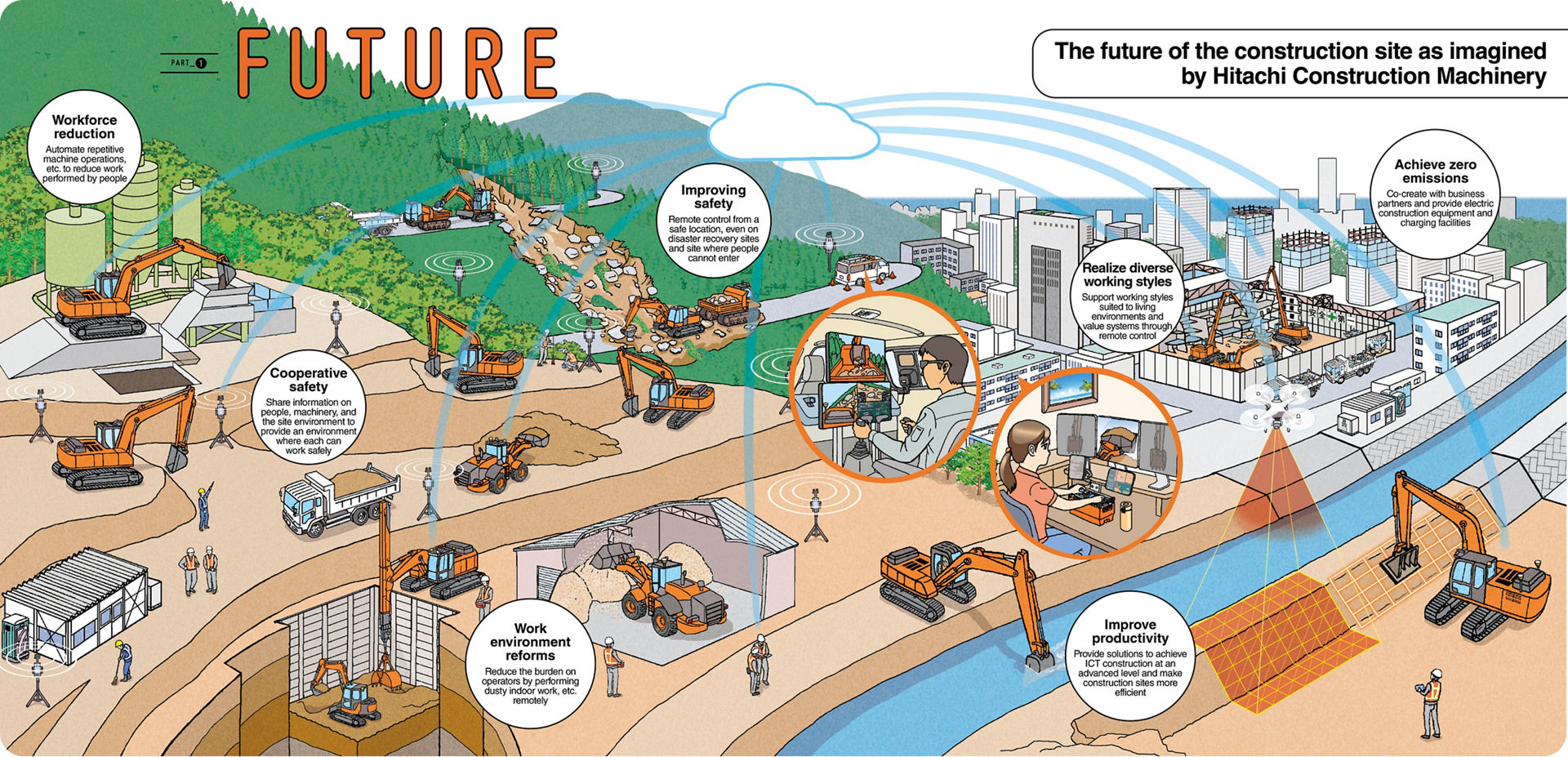PART 1 FUTURE The future of the construction site as imagined by Hitachi Construction Machinery
The future of the construction site as imagined by Hitachi Construction Machinery

Remote control, where construction machineryis operated from a distance, and automation, where work on site is entrusted to machinery, have entered the stage of practical implementation.
Let us paint a picture of the future that Hitachi Construction Machinery is aiming for through remote control and automation and its efforts to reach it, based on interviews.
Text: Toshiaki Saito . Illustrations: Shinjiro Iwata. Photos: Norio Sekine
The worldview of remote control and automation that Hitachi Construction Machinery aims for
Conventional construction machinery is operated by people on board it. If the work site is far from town, it takes the people time to travel there, and depending on the environment, they may suffer physical or mental burden. Ensuring safety when the machinery is operating is also left to people for the most part, and it is probably impossible to reduce the potential for human error to zero.
The recent decline in the productive working population has made it difficult to secure human resources, and transferring know-how from veteran operators who are thoroughly familiar with operations to younger workers is also no easy task. These are the challenges on construction sites that Hitachi Construction Machinery seeks to provide support for in its position as a construction machinery manufacturer.
The construction site of the future that Hitachi Construction Machinery imagines is a place where information about people, machinery, and construction environments within the site is linked to achieve “collaborative safety” that works to autonomously improve safety and productivity. They are currently accelerating development of workforce reductions through remote control and automated operation of construction machinery.
To respond promptly to demand for remote control and automated operation, Hitachi Construction Machinery has developed ZCORE, a system platform in which the construction machinery itself performs the “recognize, judge and execute” process that operators perform when working.
A future in which people and machinery share information
There have been machines that can be operated by giving orders remotely using a remote control. However, this is nothing more than providing information from only one direction. Achieving remote operation and automation requires people, machinery, and the site environment to share information with each other, says Shinya Imura of the Advanced Development Center. “Having the machinery also send operational data and the like makes it possible to have information cooperation in both directions between the people and the machinery. This achieves speedier, more accurate construction and can also improve safety.” Hitachi Construction Machinery did not individually develop remotely operated and automated construction machinery capable of bidirectional information sharing, but added them to its product lineup as machines specifically for remote operation and automation.
Increasing the number of work sites where construction machinery can operate by remote control or automation will contribute to improved safety and productivity. In addition, it may also be a solution to various challenges, like a lack of human resources and environmental problems. “For example, it would allow one operator to operate machinery of multiple sites from one place. This would lead to a solution for the challenge of the current situation, where it is not possible to secure enough workers, not to mention improving work efficiency,” says Katsuaki Kodaka of the Solution Carrier Products Development Department.
Further, to explain the value that remote control is likely to produce, Kazuki Sakai of the Client Solutions Division notes, “To reduce the burden on operators due to the decreasing working population and the impact from the site environment, we must think about working style reforms for operators and ensuring productivity. For example, it will be possible to use time more effectively, such as by eliminating travel time and by remotely controlling equipment on another site during waiting times.”
An era when it is not unusual for people not to be on board construction machinery on sites is approaching. It is easy to imagine that construction sites will change significantly. This is certainly not a dream—Hitachi Construction Machinery has already taken its steady first steps.

